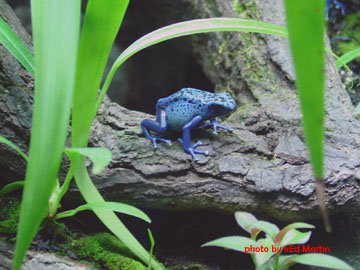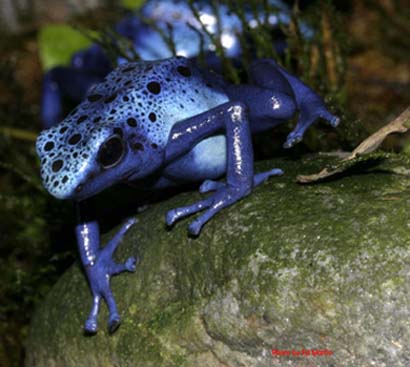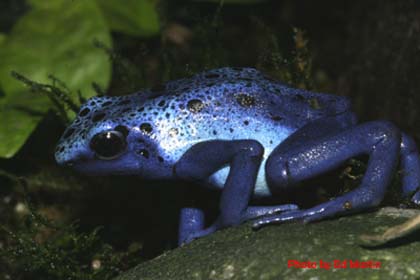  |
Dendrobates azureus is a beautiful frog. In the wild this frog inhabits a very small area southernmost part of Surinam near the Brazilian border known as the Sipaliwini Savannah. This area is made up of a few tiny populations that are very susceptible to habitat degradation. It is one of the rarest poison dart frogs in the wild and because of the small geographic area that they inhabit, almost always in danger of extinction in the wild.
This species was first bred in the U.S. at the National Aquarium in Baltimore from a small group of 10 animals in the late 1980's. Subsequent generations of animals were bred with imported stock, but the genetic diversity of this species in captivity is limited. Despite this, D. azureus is very common in captivity and one of the most popular species for hobbyists. In our experience these frogs climb and will take advantage of vertical space. They are bold but still like a heavily planted enclosure to make them feel secure. They are a large blue frog and spend a lot of time in the lower sections of the enclosure in the moss and leaf litter. They are aggressive feeders and accept a wide variety of appropriately sized food. The sexual dimorphism in D. azureus is the same as D. tinctorius, the males have much larger front toe pads than females. The females are also often larger than the males. The males can start calling at about 10 - 12 months but the call is very soft and hard to hear, it is usually easier to see the males calling than hear them. Toe pad size is the surest way to know that you have a male. These frogs are best kept in pairs or in 2:1 (2 males to 1 female) ratios. Adult females can be very aggressive toward each other and although it is rare for frogs to kill each other the stress caused by constant bullying can be fatal. A large, heavily planted enclosure will allow subordinate animals to escape the bullying and permit keeping these frogs in groups. The females initiate breeding in the species. She approaches and gently strokes the male, he responds by calling the female to him and leading her to an egg laying site. Mating usually takes place in some type of bower.
If you keep a group of frogs, you can take notes on the pattern of all your animals to keep a record of the sex and observations of the individuals. |
D. azureus lay clutches of 4 to 8 eggs but a healthy pair can lay eggs every one or two weeks. The eggs are usually laid in a coco hut or similar bower. We leave the eggs in the enclosure for at least 24 hours after finding them to make sure that they are fertilized. The hatch rate for D. azureus eggs is usually high. We raise our tadpoles individually in glass mason jars or in nested rubbermaid containers that have dividers and a screen bottom on the inside container. This setup is filtered with a small sponge type air filter. Filtration reduces the number of water changes needed. In this type of setup we keep pathos and aquatic plants in the rearing enclosure. Tads are fed a mixture of spirulina, chlorella, stinging nettle and bee pollen (2:2:1:1), we also feed "Aquarian" fish food about once a week. After the rear legs develop we expose the tads to UVB lighting daily. The tads morph out fairly large and are fed Drosophila melanogaster that are dusted daily with Repcal. We also dust weekly with Herptivite. We follow this dusting regime with our adult frogs too. The frogs reach maturity in 12-15 months. |
 |
 |
Summation:
Size- 35 - 40 mm, visual differences between sexes are apparent, females are slightly larger and rounder, males have a much larger toe pads on the front feet
Care- azureus are easy to care for and a bold species.
Food- all types of fruit flies, small crickets, waxworms, confused flowerbeetle larvae, termites, field sweeping,
Eggs and Tads- clutches of 4 to 8 eggs, tads are omnivorous and should be raised singly
Temperature- 70°-80°
Locality - Sipaliwini Savannah in the southernmost part of Surinam near the Brazilian border
|
|
|

